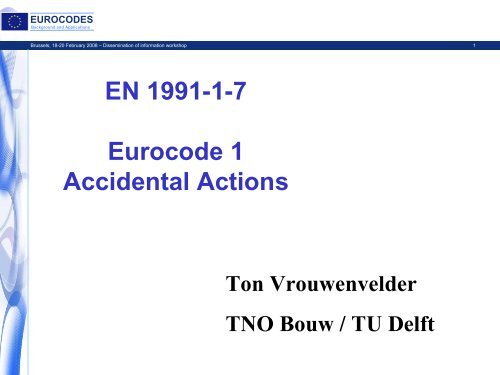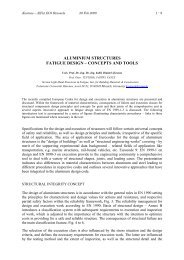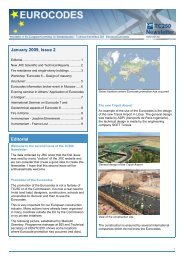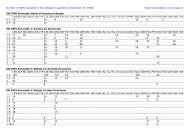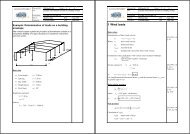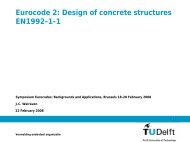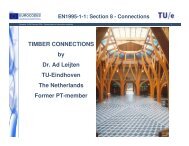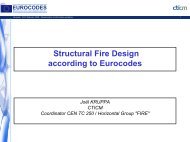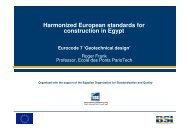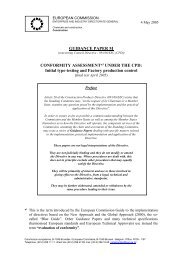EN 1991-1-7 Eurocode 1 Accidental Actions - Eurocodes
EN 1991-1-7 Eurocode 1 Accidental Actions - Eurocodes
EN 1991-1-7 Eurocode 1 Accidental Actions - Eurocodes
You also want an ePaper? Increase the reach of your titles
YUMPU automatically turns print PDFs into web optimized ePapers that Google loves.
EUROCODESBackground and ApplicationsBrussels, 18-20 February 2008 – Dissemination of information workshop 2<strong>EN</strong> 1990 Section 2.1 Basic Requirements(4)P A structure shall be designed and executedin such a way that it will not be damaged by eventslike-explosion- impact and- consequences of human errorsto an extent disproportionate to the original causeNote: Further information is given in <strong>EN</strong> <strong>1991</strong>-1-7
EUROCODESBackground and ApplicationsBrussels, 18-20 February 2008 – Dissemination of information workshop 3<strong>EN</strong> 1990 guidance:‣ reducing hazards‣ low sensitive structural form‣ survival of local damage‣ sufficient warning at collapse‣ tying members
EUROCODESBackground and ApplicationsBrussels, 18-20 February 2008 – Dissemination of information workshop 4
EUROCODESBackground and ApplicationsBrussels, 18-20 February 2008 – Dissemination of information workshop 5World Trade CenterUSA, 2001
EUROCODESBackground and ApplicationsBrussels, 18-20 February 2008 – Dissemination of information workshop 6<strong>Eurocode</strong> <strong>EN</strong> <strong>1991</strong>-1-71. General2. Classification3. Design situations4. Impact5. ExplosionsAnnexesA. Design for localised failureB. Risk analysisC. DynamicsD. Explosions
EUROCODESBackground and ApplicationsBrussels, 18-20 February 2008 – Dissemination of information workshop 73 Design strategies
EUROCODESBackground and Applications4. ImpactBrussels, 18-20 February 2008 – Dissemination of information workshop 8Type of road Vehicle type F d,x [kN]MotorwayCountry roadsUrban areaParking placeParking placeTruckTruckTruckTruckPassenger car100075050015050
EUROCODESBackground and ApplicationsBrussels, 18-20 February 2008 – Dissemination of information workshop 9Annex B: scenario model
EUROCODESBackground and ApplicationsAnnex C: force modelBrussels, 18-20 February 2008 – Dissemination of information workshop 102500F[kN]200015001000upperlowertheorie50000 1000 2000 3000 4000 5000E [kNm]F=v√(km)model en experiment
EUROCODESBackground and ApplicationsBrussels, 18-20 February 2008 – Dissemination of information workshop 11Table 4.2.1: Data for probabilistic collision force calculationvariable designation type mean stand devn number of lorries/day deterministic 5000 -T reference time deterministic 100 years -λ accident rate deterministic 10 -10 m -1 -b width of a vehicle deterministic 2.50 m -α angle of collision course rayleigh 10 o 10 ov vehicle velocity lognormal 80 km/hr 10 km/hra deceleration lognormal 4 m 2 /s 1.3 m/s 2m vehicle mass normal 20 ton 12 tonk vehicle stiffness deterministic 300 kN/m -
EUROCODESBackground and ApplicationsBrussels, 18-20 February 2008 – Dissemination of information workshop 123000force [kN]2500eq 4.3.7200015001000500010 20 30 40 50distance [m]Life time exceedence probability: 10 -3
EUROCODESBackground and ApplicationsDesign example: bridge column in motorwayBrussels, 18-20 February 2008 – Dissemination of information workshop 13xF dyH hyabb width 0.50 mh thickness 1.00 mH column height 5 mf y yield stress steel 300 MPaf c concrete strength 50 MPaρ reinforcement ratio 0.01
EUROCODESBackground and ApplicationsBrussels, 18-20 February 2008 – Dissemination of information workshop 14Bending moment:M dx =a(H − a )HF dx =1.25(5.00−1.25)5.001000 = 940 kNmResistance:M Rdx= 0.8 ω h 2 b f y= 0.8 0.01 1.00 2 0.50 300 000= 1200 kNm > 940 kNm
EUROCODESBackground and ApplicationsBrussels, 18-20 February 2008 – Dissemination of information workshop 155 + Annex D:gas explosions in buildingsgas explosions in tunnelsdust explosions
EUROCODESBackground and ApplicationsBrussels, 18-20 February 2008 – Dissemination of information workshop 16INTERNAL NATURAL GAS EXPLOSIONSThe design pressure is the maximum of:p d= 3 + p vp d= 3 + 0.5p v+0,04/(A v/V) 2p d= nominal equivalent static pressure [kN/m 2 ]A v= area of venting components [m 2 ]V = volume of room [m 3 ]Validity: V < 1000 m 3 ; 0,05 m -1 < A v/ V < 0,15 m -1Annex B: load duration = 0.2 s
EUROCODESBackground and ApplicationsDesign Example: Compartment in a multi story buildingBrussels, 18-20 February 2008 – Dissemination of information workshop 17H = 3m p dB = 8 mCompartment: 3 x 8 x 14 mTwo glass walls (p v=3 kN/m 2 ) and two concrete walls
EUROCODESBackground and ApplicationsBrussels, 18-20 February 2008 – Dissemination of information workshop 18explosion pressure:p Ed=3+ p v/2 + 0,04/(A v/V) 2= 3 + 1.5 + 0.04 / 0.144 2 = 6.5 kN/m 2self weight = 3.0 kN/m 2live load = 2.0 kN/m 2Design load combination (bottom floor):p da= p SW+ p E+ ψ 1LLp LL= 3.00 + 6.50 + 0.5*2.00 = 10.50 kN/m 2
EUROCODESBackground and ApplicationsDynamic increase in load carrying capacityBrussels, 18-20 February 2008 – Dissemination of information workshop 19ϕ d = 1 +ppSWRd2 ug ( Δ tΔt = 0.2 s = load durationg = 10 m/s 2u max= 0.20 m = midspan deflection at collapsep sw = 3,0 kN/m 2 and p Rd =7.7 kN/m 2max)2ϕ d = [1 +37 .7210* 0 .20(0 .2 )2] = 1.6p REd= ϕ dp Rd= 1.6 * 7.7 = 12.5 kN/m 2 > 10.5 kN/m2Conclusion: bottom floor system okay
EUROCODESBackground and ApplicationsBrussels, 18-20 February 2008 – Dissemination of information workshop 20Be careful for upper floors and columnsP swp Eedge centrecolumn columnB
EUROCODESBackground and ApplicationsBrussels, 18-20 February 2008 – Dissemination of information workshop 21BLEVE in eenoverkluizing
EUROCODESBackground and ApplicationsBrussels, 18-20 February 2008 – Dissemination of information workshop 22YXYZX
EUROCODESBackground and ApplicationsBrussels, 18-20 February 2008 – Dissemination of information workshop 23ZYX.1E-1.9E-2.8E-2.7E-2.6E-2.5E-2.4E-2.3E-2.2E-2.1E-20
EUROCODESBackground and ApplicationsBrussels, 18-20 February 2008 – Dissemination of information workshop 24Annex A: Classification of buildingsConsequences classclass 1class 2, lower groupclass 2, upper groupclass 3Example structureslow rise buildings where only few people are presentmost buildings up to 4 storiesmost buildings up to 15 storieshigh rise building, grand stands etc.
EUROCODESBackground and ApplicationsBrussels, 18-20 February 2008 – Dissemination of information workshop 25Annex A: What to doClass 1Class 2, Lower GroupFramesClass 2, Lower groupWall structuresClass 2, Upper GroupClass 3No special considerationsHorizontal ties in floorsFull cellular shapesFloor to wall anchoring.Horizontal ties and effective vertical tiesOR limited damage on notional removalOR special design of key elementsRisk analysis and/or advancedmechanical analysis recommended
EUROCODESBackground and ApplicationsBrussels, 18-20 February 2008 – Dissemination of information workshop 26Class 2a (lower group)s = 4 ms = 4 minterne trekbandT iL = 5 malle liggers kunnen wordenontworpen om als trekbandte dienenomtrek trekband T pinterne trekband T irandkolom
EUROCODESBackground and ApplicationsClass 2a (lower group)Brussels, 18-20 February 2008 – Dissemination of information workshop 27s = 4 ms = 4 minterne trekband2Ø12L = 5 momtrek trekband 2Ø12interne trekband2Ø12randkolomT i= 0.8 (g k+Ψ q k)sL = 0.8{3+0.5*3}x4x5=88 kN>75 kNFeB 500: A = 202 mm 2 or 2 Ø12mm
EUROCODESBackground and ApplicationsBackground horizontal typingsBrussels, 18-20 February 2008 – Dissemination of information workshop 28total load on center columnR = (g k + ψ q k ) L s = p L ss sL LT iT iT i= 0,8 s L p T imiddenkolom
EUROCODESBackground and ApplicationsBackground typing forcesBrussels, 18-20 February 2008 – Dissemination of information workshop 29T i = 0.75 p s LEquilibirum for δ = (s+L)/6drukkrachtenRtrekkrachtenverplaatsing δδXRXT i
EUROCODESBackground and ApplicationsBrussels, 18-20 February 2008 – Dissemination of information workshop 30Suggestion:design cornercolumn as akey element.
EUROCODESBackground and ApplicationsBrussels, 18-20 February 2008 – Dissemination of information workshop 31Example structure, Class 2, Upper Group, FramedL =7.2 m, s =6 m, q k=g k=4 kN/m 2 , Ψ=1.0internal tiesLperimeter ties
EUROCODESBackground and ApplicationsBrussels, 18-20 February 2008 – Dissemination of information workshop 32Example structureInternal horizontal tie forceT i= 0.8 (g k+ Ψ q k) s L = 0.8 {4+4} (6 x 7.2) = 276 kNFeB 500: A = 550 mm 2 or 2 ø18 mm.Vertical tying force:T i= (g k+ Ψ q k) s L = {4+4} (6 x 7.2) = 350 kNFeB 500: A = 700 mm 2 or 3 ø18 mm.
EUROCODESBackground and ApplicationsBrussels, 18-20 February 2008 – Dissemination of information workshop 33Class 2 higher class – walls1,2 mzinterne trekband T iomtrek trekband T pinternetrekband T idragende wand
EUROCODESBackground and ApplicationsClass 2 higher class – wallsBrussels, 18-20 February 2008 – Dissemination of information workshop 34TyingsHorizontal:T i = F t (g k + ψq k ) /7,5 × z/5 kN/m > F tPeriphery: T p = F tVertical: T = 34 A / 8000 × (H/t)² in N > 100 kN/mF tn szAHt= 20 + 4n s kN/m < 60 kN/m= number of storeys= span= horizontal cross section of wall [mm²]= free storey height= wall thickness
EUROCODESBackground and ApplicationsClass 2 higher class – wallsBrussels, 18-20 February 2008 – Dissemination of information workshop 35Design Example:L = 7,2 m, H = 2,8 m en t = 250 mmT = 34×7200×250/8000 × (2800/250)² == 960 ×10³ N = 960 kN > 720 kNmaximal distance 5 mmaximal distance from edge: 2.5 mResult: 2 tyings of 480 kN
EUROCODESBackground and ApplicationsBrussels, 18-20 February 2008 – Dissemination of information workshop 36Effect of tyings in walls
EUROCODESBackground and ApplicationsBrussels, 18-20 February 2008 – Dissemination of information workshop 37Effect of vertical tyingsgaping
EUROCODESBackground and Applicationsclass 3: Risk analysisBrussels, 18-20 February 2008 – Dissemination of information workshop 38Guidancecan be found inAnnex B:Definition of scope and limitationsQualitative Risk analysis• hazard identification• hazard scenarios• description of consequences Reconsideration• definition of measures of scope and assumptionsQuantitative Risk Analyisis• inventory of uncertainties• modelling of uncertatinties• probabilistic calculations• quantification of consequences• calculation of risksRisk management• risk acceptance criteria• decision on measuresPresentation
EUROCODESBackground and ApplicationsBrussels, 18-20 February 2008 – Dissemination of information workshop 39Risk AnalysisEastern ScheldtStorm Surge Barrier(1980)
EUROCODESBackground and ApplicationsBrussels, 18-20 February 2008 – Dissemination of information workshop 40Office building Zwolle (The Netherlands)London Eye
EUROCODESBackground and ApplicationsBrussels, 18-20 February 2008 – Dissemination of information workshop 41Points of attention in risk analysis• list of hazards• irregular structural shapes new• construction types or materials• number of potential casualties• strategic role (lifelines)
EUROCODESBackground and ApplicationshazardsBrussels, 18-20 February 2008 – Dissemination of information workshop 42EarthquakeLandslideTornadoAvalancheRock fallHigh groundwaterFloodVolcano eruptionInternal explosionExternal explosionInternal fireExternal fireImpact by vehicle etcMining subsidenceEnvironmental attackVandalismDemonstrationsTerrorist attackDesign errorMaterial errorConstruction errorUser errorLack of maintenance
EUROCODESBackground and ApplicationsBrussels, 18-20 February 2008 – Dissemination of information workshop 43Step 1 Step 2 Step 3Identifical and modellingof relevant accidentalhazardsAssessment of damagestates to structure fromdifferent hazardsAssessment of theperformance of thedamaged structureAssessment of the probability ofoccurence of different hazardswith different intensitiesAssessment of the probability ofdifferent states of damage andcorresponding consequencesfor given hazardsAssessment of the probability of inadequateperformance(s) of the damaged structuretogether with the corresponding consequence(s)
EUROCODESBackground and ApplicationsBrussels, 18-20 February 2008 – Dissemination of information workshop 44Risk calculation:Step 1: identification of hazard H iStep 2: damage D jat given hazardStep 3: structural behavour S kand cpmsequences C(S k)Risk=p(Hi) p(DjHi) p(SkDj)C(Sk)Take sum over all hazards and damage types
EUROCODESBackground and ApplicationsConclusionsBrussels, 18-20 February 2008 – Dissemination of information workshop 45<strong>EN</strong> <strong>1991</strong>-1-7: valuable document,but not a masterpiece of European harmonisationReasons: large prior differences member state autonomy in safety matters legal status different in every countryIt will be interesting to see the National Annexes and NDP’s .
EUROCODESBackground and ApplicationsBrussels, 18-20 February 2008 – Dissemination of information workshop 46Relevant Background DocumentsISO-documentsCOST actions C28 and TU0601Background document for the <strong>EN</strong>V-version of EC1 Part 2-7(TNO, The Netherlands, 1999)Leonardo da Vinci Project CZ/02/B/F/PP-134007Handbooks Implementtion of <strong>Eurocode</strong>s (2005)


